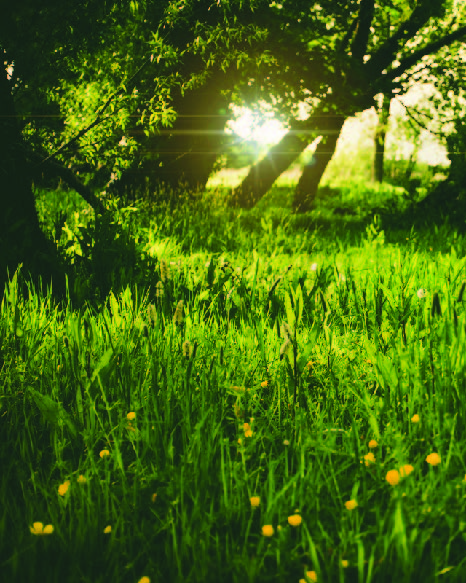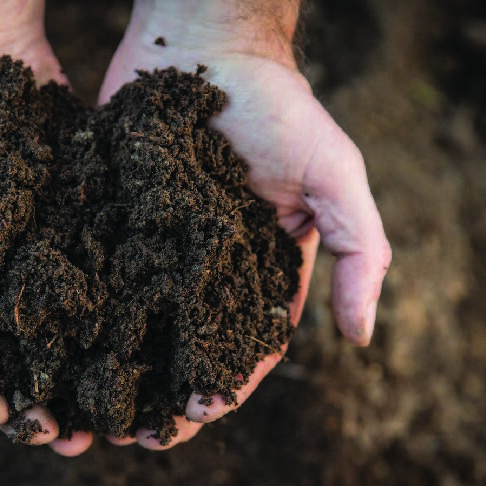While many communities value attractive lawns, traditional turf grasses and standard lawn maintenance activities can be both expensive and harmful to water resources. Consider the following strategies to save money and reduce your environmental impact.
Plant Turf Alternatives
Selecting a grass species can greatly impact your lawn’s needs. Most lawns use Kentucky bluegrass, which requires more watering, mowing, and fertilizing than the following alternatives:
- Plant native grasses: They require less water and fertilizer, are more resistant to pests and disease, and increase water infiltration into the soil with their deep root systems.
- Plant low mow lawns: Slow-growing and drought-tolerant fine fescue grasses only need to be mowed twice per year.
- Plant bee lawns: Drought-tolerant fine fescues and low-growing perennials provide nectar for pollinator species.
- Limit turf: Plant Kentucky bluegrass only where it has a practical function, like children’s play areas.
Visit bluethumb.org/turf-alternatives to learn how to get started, and contact your local watershed for grant opportunities to transition your existing lawn.


Promote Healthy Soil
The health of your soil greatly affects the health of your lawn and can be impacted by erosion, compaction, and lack of organic matter. Practice these soil health principles:
- Aerate your soil: This increases infiltration to the plant's roots and reduces stormwater runoff.
- Test your soil: Testing your soil helps reduce your fertilizer use. A standard soil test from UMN costs $20 and will help determine which nutrients your lawn needs.
- Amend your soil: Adding material to your soil helps reduce compaction. In the fall, add compost, mulch, and leave leaf residue. In the summer, leave lawn clippings after mowing.
Mow Smarter
Mowing is necessary, but cutting the blades too short can harm your lawn. Follow these best practices for lawn health:
- Mow at the highest setting (at least 3"): Reduce the amount of grass being cut to better capture pollutants, crowd out weeds, and develop deep drought-resistant root systems.
- Mow regularly: Avoid removing more than 1/3 of the leaf blade during each mow to reduce stress and vulnerability to disease, drought, and insect or weed invasion.
- Mow less or skip during dry periods.


Limit Fertilizer & Lawn Chemicals
While fertilizers promote growth, pesticides kill bugs, and herbicides kill weeds, they also pollute the water. Consider the following:
- Fertilize with grass clippings: They are a natural source of nutrients.
- Use natural organic or slow-release fertilizers: They feed plants slowly and evenly to help increase lawn health.
- Fertilize less often: Only apply fertilizer in the late summer and fall.
- Maintain a buffer zone: Do not use fertilizers or lawn chemicals within ten feet of water bodies and storm drains.
- Spot treat bugs and weeds: Treat only small areas to reduce chemicals.
Water Less
Over-watering wastes water resources and increases nutrients and pollutants running into water bodies.
- Audit your irrigation: This will help identify leaks and suggest strategies for making your system more efficient.
- Water less often for longer: Lawns only need about 1" of water per week, which is about 20 minutes twice per week without rain.
- Avoid mid-day watering: Water is more likely to be evaporated from the hot sun, requiring more water to satisfy the lawn.
- Use efficient sprinklers: Ensure your irrigation system has a smart controller and soil moisture sensor to avoid unnecessary watering. Pressure-regulating systems can save 32,000 gallons of water per year, per household and $4,000 per 100 households.

Additional Lawn Resources
- U of M Extension Lawn Care: extension.umn.edu/lawns-and-landscapes/lawn-care
- What to do with lawn clippings: extension.umn.edu/lawn-care/what-do-lawn-clippings
- Mowing practices for healthy lawns: extension.umn.edu/lawn-care/mowing-practices-healthy-lawns
- Water-saving strategies for home lawns: extension.umn.edu/lawn-care/water-saving-strategies-home-lawns
- Fertilizing lawns: extension.umn.edu/lawn-care/fertilizing-lawns
- Planting and maintaining a fine fescue lawn: extension.umn.edu/lawns-and-landscapes/planting-and-maintaining-fine-fescue-lawn
- U of M Turfgrass Science Blog: www.turf.umn.edu
- Sustainable Landscape Information Series: www.sustland.umn.edu
- ET estimates for Minnesota: http://agweather.cals.wisc.edu/sun_water/et_wimn
- U of M Climatology Working Group: http://climate.umn.edu/
